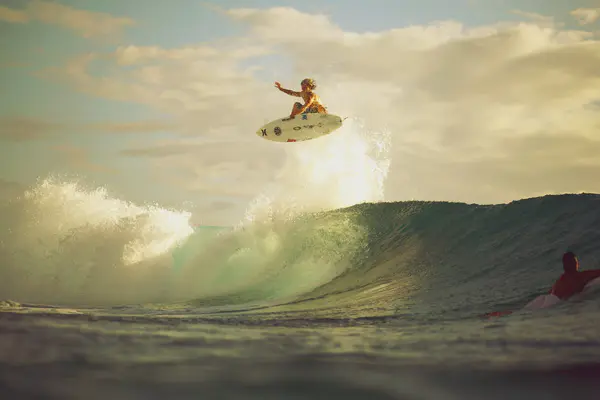Surfing is a thrilling and dynamic sport that combines balance, strength, and an understanding of the ocean. One of the key concepts in surfing is understanding the different types of waves, specifically “left waves.” This article will delve into what a left wave is, how it forms, why it is important, and how surfers can effectively ride these waves.
Understanding Surfing Waves
Surfing involves riding waves on a surfboard, using the power of the ocean to propel oneself towards the shore. Waves are formed by wind blowing across the surface of the water, transferring energy into the ocean. This energy creates swells, which travel across the water until they reach the shore, where they break and form waves suitable for surfing.
Left Wave Defined
A left wave, also known as a “left-hander,” breaks from right to left from the perspective of the surfer facing the shore. This means that the wave peels to the left when viewed from the beach. For a surfer paddling to catch a wave, a left wave will break to their left side, allowing them to surf in that direction.
Formation of Left Waves
Left waves form under specific conditions. The direction and strength of the wind, the shape of the ocean floor (bathymetry), and the orientation of the coastline all play a role in wave formation. When these elements align correctly, they create waves that break to the left.
Importance of Left Waves
Understanding left waves is crucial for surfers. It determines their positioning in the water, the techniques they use, and their overall strategy. Different waves offer unique challenges and opportunities, and left waves are no exception.
See Also: What Is a Kook in Surfing Terms
Surfing a Left Wave
Surfing a left wave requires specific skills and techniques. Surfers need to position themselves correctly, paddle efficiently, and make quick decisions to ride the wave effectively. Here are some key aspects of surfing a left wave:
- Positioning: Position yourself slightly to the right of the peak of the wave. This allows you to take off into the wave’s left-hand break.
- Paddling: Paddle with strong, deep strokes to gain enough speed to catch the wave. Angle your board slightly to the left.
- Takeoff: Pop up quickly and smoothly as the wave lifts you. Your feet should be positioned towards the center of the board.
- Riding the Wave: Shift your weight slightly to the left rail of the board to carve into the wave. Use your back foot to steer and control your speed.
- Maneuvers: Perform turns, cutbacks, and other maneuvers to stay in the wave’s power pocket and maximize your ride.
Types of Left Waves
Left waves can vary based on their size, shape, and power. Here are some common types of left waves:
- Beach Breaks: These waves break over sandy bottoms and can be less predictable. They are often suitable for beginners.
- Reef Breaks: These waves break over coral or rocky reefs, providing more consistent and powerful waves. They are better suited for experienced surfers.
- Point Breaks: These waves break along a point of land, creating long, peeling waves that can offer extended rides. They are popular among surfers of all levels.
Notable Left Wave Surf Spots
Several surf spots around the world are renowned for their left waves. These spots attract surfers from all over, seeking the thrill and challenge of riding these waves. Some of the most famous left wave surf spots include:
- Uluwatu, Bali: Known for its powerful and consistent left-hand waves, Uluwatu is a favorite among experienced surfers.
- Raglan, New Zealand: Raglan offers long, peeling left-hand waves that provide excellent rides for surfers of all levels.
- Jeffreys Bay, South Africa: While Jeffreys Bay is famous for its right-hand point break, it also offers quality left-hand waves during certain conditions.
Surfing Etiquette on Left Waves
Surfing etiquette is crucial to ensure safety and respect among surfers. Here are some key points to remember when surfing left waves:
- Priority: The surfer closest to the peak has the right of way. Do not drop in on someone else’s wave.
- Communication: Communicate with other surfers to avoid collisions and ensure everyone gets a fair share of waves.
- Respect: Respect the local surfers and follow the rules of the surf spot.
Training for Left Waves
To excel at surfing left waves, surfers need to train both in and out of the water. Here are some training tips:
- Balance and Core Strength: Engage in exercises that improve balance and strengthen the core, such as yoga and pilates.
- Cardio and Endurance: Swimming, running, and other cardio exercises help build endurance and stamina.
- Surf-Specific Drills: Practice pop-ups, paddling techniques, and maneuvers on land to build muscle memory.
Conclusion
In conclusion, a left wave in surfing is a wave that breaks to the left of the surfer. It is caused by factors such as wind direction, tides, and seafloor shape. Left waves provide unique opportunities for surfers to perform tricks and showcase their skills. Whether you’re a beginner or an experienced surfer, understanding the different types of waves can help you improve your surfing abilities.

